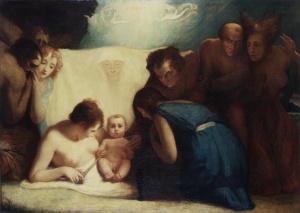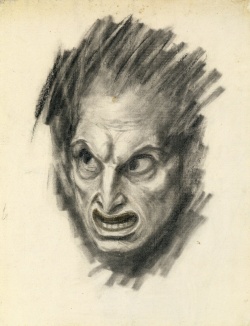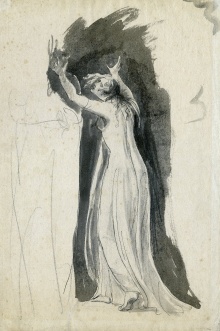Designs from Fancy: George Romney's Shakespearean Drawings

Designs from Fancy: George Romney's Shakespearean Drawings part of the Exhibitions at the Folger, opened November 10, 1998 and closed March 20, 1999. The exhibition catalog can be purchased from the Folger Shop.
George Romney (1734-1802) was one of the most successful English artists of the late eighteenth century. Born in the north of England, where he was apprenticed briefly to Christopher Steele, Romney was essentially self-taught. In 1762 he left his family behind in Kendal and moved to London to seek his fortune there. Hard-working and adept at capturing a flattering image of his sitters, Romney quickly established a lucrative practice as a portrait painter. He had a fierce ambition, however, to achieve fame in the more highly regarded art of history painting, a category that included subjects from literary, religious, and mythological sources as well as from history.
The Folger Shakespeare Library is fortunate to possess nearly 500 drawings by George Romney, the second largest collection of Romney drawings in America. The Folger collection has remained little known since very few of the drawings have ever been reproduced or exhibited—a situation this exhibition sought to address. For a complete catalog of the Folger's Romney drawings see, The Drawings of George Romney, by Yvonne Dixon.
Romney has long received recognition as a major British artist of the eighteenth century, but his drawings have remained virtually unknown. In this country it is only during the past few decades that they have begun to be exhibited and studied. This exhibition offered a new opportunity to discover the appeal of George Romney's draftsmanship, their charm, and their distinctive personality.
Chronology
1734: December 26, born at Beckside near Dalton in Furness, Lancashire.
1755: Apprenticed to Christopher Steele for four years.
1756: October 14, marries Mary Abbot, the daughter of his landlady.
1757: Leaves Steele after two years of working with the artist in York, Lancaster, and Kendal. Becomes his own master.
April 6, birth of his son, John Romney, who would become his father's biographer.
1762: Disposes of twenty paintings by lottery at the Kendal Town Hall.
Departs for London on March 14.
1763: First exhibits at the Free Society of Artists, which awards him twenty five guineas for his The death of General Wolfe.
Continues to place works on exhibition at the Free Society until 1769.
1764: Leaves in September, with his friend Thomas Greene, for a six week trip to Paris where he meets Joseph Vernet.

1765: Receives a 50 guinea award from the Free Society for his The death of King Edmund.
Visits family in the North. Romney's wife had, by this time, left Kendal to live with and look after Romney's father at Dalton. Spends much of his time while in the North painting portraits in Lancaster.
1767: Again visits family and paints portraits in the North.
1769: Exhibits for the last time at the Free Society.
1770: His first exhibition at the Society of Artists (Mirth and Melancholy).
1772: Exhibits two portraits at the Society of Artists. Romney's last participation in regular public exhibitions.
1773: March 20, departs for Rome with the painter Ozias Humphry; travels via Paris, Lyons, and the south of France to Nice and Menton. From Menton, travels to Genoa and Leghorn, continuing on to Pisa, Florence, and Siena. Arrives in Rome on June 18.
1775: Leaves Rome in early January, spending time in various other Italian cities (Florence, Bologna, Ferrara, Venice, Parma) as well as Lyon and Paris, before arriving back in London on July 1. In late November, Romney takes over the lease on Francis Cotes's large house in Cavendish Square.
1776: Meets the poet William Hayley, who becomes Romney's closest friend. Hayley initiates his yearly invitations to Romney to spend his summer holidays with him at Eartham, near the south coast. Annual visits occur for the next twenty years.
1777: Romney joins other friends in forming the eight-member Unincreasables Club, which included the Shakespearean actor John Henderson.
1778: Publication of Hayley's Poetical epistle to an eminent painter, addressed to Romney.
1780: Henderson sits for Romney in October and December.
1782: Emma Hart begins to sit regularly for Romney and does so until her departure for Naples in 1786.
1786: Romney attends a dinner at the home of Josiah Boydell where the idea of a Shakespeare Gallery is discussed; by some accounts, it is initially proposed by Romney himself.
1790: Romney's Tempest painting completed and sent to the Boydell Gallery in Pall Mall.
At the end of July, Romney takes a six-week trip to France with Hayley and Thomas Carwardine.
Death of the philanthropist John Howard stimulated Romney's interest in illustrating Howard's prison visits.
1791: In September, Emma Hart becomes Lady Hamilton upon her marriage to Sir William. Emma sits a number of times for Romney while in London.
1792: Romney's The infant Shakespeare attended by Nature and the Passions and Cassandra Raving are sent to the Boydell Gallery.
Commissions John Flaxman to buy antique casts for him in Rome.
1794: Romney's health begins to give way; he becomes increasingly melancholic.
1796: Suffers the first of a series of strokes.
1798: Visits the North of England with his son John during the summer. Suffers a slight stroke in the winter, experiences increasing debility.
1799: Returns to the North for good where he is nursed by his wife.
1802: November 15, Romney dies in Kendal.
Exhibition material

Early Career
Romney needed to paint portraits to earn a living, but his bias is clear in his complaint: "This cursed portrait painting! How I am shackled with it! I am determined to live frugally, that I may enable myself to cut it short as soon as I am tolerably independent, and then give my mind up to those delightful regions of imagination."
That his attention shifted easily from portraits to historical subjects is demonstrated in one sketchbook drawing combining two separate images. At the right is a portrait study of a seated woman in contemporary dress. Sharing the page at the left is a study of a woman rushing forward, with one arm raised and the other at her forehead. This is Cassandra Raving from Shakespeare's Troilus and Cressida, the subject of a painting Romney sent to the Boydell Shakespeare Gallery. Emma Hart (Lady Hamilton) served as his model. You can view the entirety of this sketchbook in the Folger's Digital Image Collection.
Neoclassical Phase
Romney's first historical painting was King Lear in the Tempest Tearing Off His Robes, painted before the artist left Kendal in 1762. It was one of twenty Romney sold by lottery to raise money for his move to London. Although Romney had rapidly become successful as a portrait painter, he abandoned his London practice in March of 1773 and traveled to Italy to study the works of antiquity and the Italian masters of the Renaissance and Baroque periods.
Drawings made during this, the most Neoclassical phase of Romney's career, reveal a careful academic approach and the impact of his study of classical art. Both during his stay in Italy and after his return to London in 1775, Romney depicted scenes from King Lear.
A large-scale black chalk head of Lear is one of the most carefully finished of Romney's drawings in the Folger collection and, as such, among the least characteristic. Its complex modeling and strong contours give full three-dimensionality to the forms and reveal Romney at his closest approximation to the academic method. Lear's strong features and flowing hair convey something of the dynamism of Michelangelo's God from the Sistine Ceiling, while his tense expression has suggestions of that of the Laocoon, though in this mental rather than physical agony is portrayed.
Exhibition highlight
The bearded King Lear is seen again in a large-scale composition drawing of the death of Cordelia. Cordelia lies on the ground, her upper body supported by the kneeling Lear. The artist has followed closely the words Lear speaks:
- Lend me a looking glass.
- If that her breath will mist or stain the stone,
- Why, then she lives. . . .
- This feather stirs; she lives! (Act 5, scene 3, 261-63).
In the arm of the woman standing at the left, Romney's delicate line provides an ironic contrast to the bulky, shapeless mass of the arm itself with its distorted anatomy.
Shakespearean Subjects
Romney enjoyed the theater, and in the late 1770s he and other friends formed a small eight-member club called The Unincreasables. This group attended the theater together and met regularly to dine, discuss theatrical events, and hear readings of plays. One member was John Henderson (1747-1785) who, along with David Garrick, was among the most distinguished Shakespearean actors of the time. One of the four oil paintings attributed to Romney that the Folger owns is of John Henderson as Macbeth. In addition to Henderson, Romney painted other actors and actresses such as Mrs. Yates, Mrs. Siddons, and Emma Hart. Romney depicted Hart as Titania, Joan of Arc, Cassandra, and Miranda.
When Hart departed for the Continent in 1786, he found comfort in beginning his sketches for the launching of Boydell's Shakespeare Gallery. This project gave enormous impetus to the illustration of Shakespeare's plays and stands as the most important instance of patronage of history painting in eighteenth-century England. Between 1786 and 1792 the artist's creative energy was devoted primarily to working on designs for pictures for the Gallery.
Macbeth
The banquet scene from Macbeth was a subject that held Romney's interest over a period of years despite the fact that the unpopularity of his Tempest painting precluded his receiving a commission from Boydell for one on Macbeth.
A series of sketches, from c1790-92, show Macbeth restrained by Lady Macbeth as he starts in amazement at Banquo's ghost hovering above the banquet table. These are not composition studies as such since Romney does not work with individual elements in a methodical way to achieve a definitive arrangement. Yet, as the sketches multiply, Romney applies an infinite range of graphic techniques to the treatment of individual forms. Each varying slightly, the sketches move before our eyes like stop frames in cinematic progression.
One of the sketches shows the figure of Macbeth alone. This powerful figure, legs spread wide and left arm raised in a commanding gesture, is slashed authoritatively on the page, its musculature emphasized by dark wedges of shadow.
Henry VI, part II
One of the subjects Romney intended to paint for the Boydell Gallery was "Margery Jourdain and Roger Bolingbroke Conjuring Up the Fiend" from Henry VI, Part II. Like many of Romney's ideas, however, the Bolingbroke episode never resulted in a completed painting.
In a powerful study of the Fiend, Romney adopts two distinctly different means for conveying emotion. Influenced by Charles LeBrun's Passions, with its diagrammatic treatments of facial expressions, Romney relies on traditional devices for depicting strong emotion: large eyes with much white showing, knitted brow, a wide, bow-shaped mouth with teeth exposed—visual cliches that appear often in his drawings. On the other hand, Romney's rendering of the fiend's hair departs entirely from physical description, however schematic that might be. Heavy, repeated diagonal strokes set off the Fiend's head with apotropaic emphasis. The vigor and freedom of Romney's graphic technique suggests his own emotional response to his subject. This drawing employs black chalk in a more abrupt and spontaneous fashion than does the head of King Lear, dating from some ten years earlier.
Charles LeBrun
Charles LeBrun (1619-1690), French historical painter whose ornate, baroque style dominated French art for two generations.
Born in Paris, he attracted the notice of a patron, who placed him at the age of eleven in the studio of Simon Vouet. At fifteen, he received commissions from Cardinal Richelieu. By 1648, LeBrun founded the Academy of Painting and Sculpture.
In his treatise, Méthode pour apprendre à dessiner les passions (1698), LeBrun promoted the expression of the emotions in painting. It had much influence on 18th-century art theory.
The Tempest

The launching of the Boydell Shakespeare Gallery in 1786 was an important stimulus to Romney's depiction of Shakespearean themes. Between 1786 and 1792 his creative energies were largely devoted to designing pictures for the Gallery.
The Tempest, completed in 1790, was the first of Romney's Boydell paintings and his most ambitious historical commission. Romney originally planned to depict Prospero and Miranda in a wide landscape viewing the storm, but he altered his conception to combine a closeup view of these two figures along with a view of the shipwreck. Crowded with figures poorly integrated into the composition, the completed painting was unsuccessful and unpopular. Romney's favorite model, Emma Hart, provided the inspiration for his depiction of Miranda, as seen in a large-scale drawing in the Folger collection.
As You Like It
Toward the end of 1793, Romney began work on his last major subject inspired by lines from Shakespeare, the "Ages of Man" as described by Jaques in As You Like It. Most of the Folger drawings on the theme depict the first stage of life, that of the infant. Romney did not limit himself to Shakespeare's description of the babe "mewling and puking in the nurse's arms," but added his own images to those of the poet, including in the scene additional figures standing and kneeling, and the mother reclining on a couch behind.
Romney's graphic technique at this period was marked by the use of different materials and media. The paper he used in the 1790s, but not before, is a relatively heavy and smooth, cream-colored wove paper, quite different from the laid paper used earlier. His favorite medium was a softer graphite than he had used previously. The resulting style in these drawings is markedly different from that of Romney's earlier work. Darkness pervades the scenes, which are usually framed within a rectangle marked out on the page. Thick parallel strokes are laid on diagonally and belabored obsessively. Patches of shading consist of directional systems at war with one another, creating areas of tone that collide in a jarring manner. Figures register as white holes on the page. On the verge of being totally swallowed up, these figures but tenuously hold their own against the vigorous assault of the encroaching lines.
Romney experiences a serious illness in the spring of 1796, probably the first in a series of strokes that began to afflict him.
As his final years progressed, the artist was to endure old age almost as Shakespeare described it: "Last scene of all . . . is second childishness and mere oblivion, sans teeth, sans eyes, sans taste, sans everything."
Son and biographer, John Romney, wrote that in his father "Reason, that noble faculty of the mind . . . became entirely extinct before the dissolution of the body; and he departed life mentally the same as when he came into existence."
Accompanying Romney's physical decline was an intensification of the melancholia to which he had always been prone. That gloom is amply conveyed in Romney's drawings on the "Ages of Man" and in other subjects he dealt with in the mid to late 1790s.
Interest in the Supernatural
Supernatural subjects, such as witches, claimed Romney's interest repeatedly when he turned to the plays of Shakespeare. Shakespeare's Macbeth encounters the witches twice, the first time on the heath in company with Banquo (Act I, scene 3). Witches issuing from the clouds confront the protagonists in a wash drawing of the heath scene.
Later Romney used the heath scene as a vehicle for painting his friend John Henderson, the noted Shakespearean actor, in the role of Macbeth. Romney also made numerous drawings of the Cavern Scene from Macbeth (Act 4, scene 1) where, during his second encounter with the witches, Macbeth witnesses the procession of the eight kings.
Religious Subjects
Mater Dolorosa: The Mourning Mother
The majority of the Romney drawings in the Folger Library are of Shakespearean subjects, but some originally identified as Shakespearean are now known to deal with a variety of other topics. Two examples are drawings of the Mater Dolorosa (Mourning Mother), a subject Romney had been commissioned to paint in 1776 as an altarpiece for King's College, Cambridge. The commission was never completed since an Italian painting thought to be by Daniele da Volterra was placed in the chapel instead. Meanwhile, however, Romney had executed many drawings in response to the commission.
Always inspired to make multiple studies for a particular subject even when a small number might suffice, Romney here employs vividly contrasting techniques in depicting the same image. The first drawing is executed entirely in thick ribbons of wash applied over a light graphite sketch. The second is a liltingly calligraphic pen and ink study. Although the technical methods differ radically, the pose of the figures in the two drawings is identical.
Like many others in the exhibition, these drawings illustrate a characteristic feature of Romney's draftsmanship: the astonishing range of his graphic techniques. In their great variety of technical methods and in their emotional force, it is Romney's drawings that speak most directly to the modern viewer.